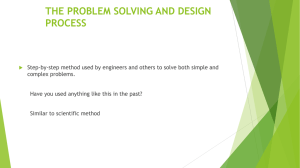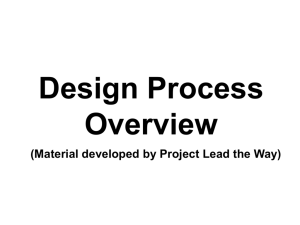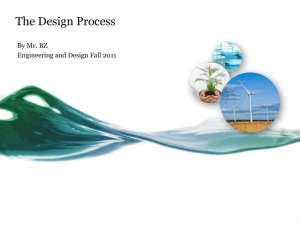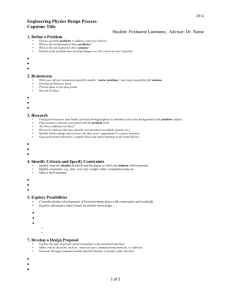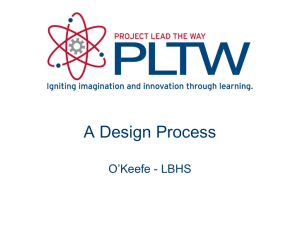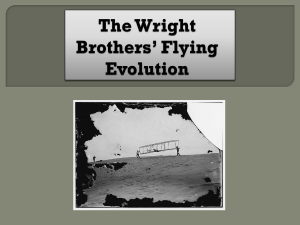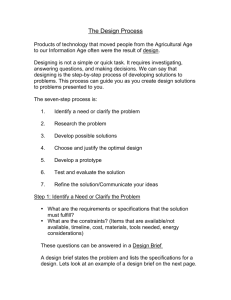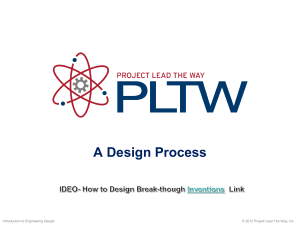Design Process Overview
advertisement
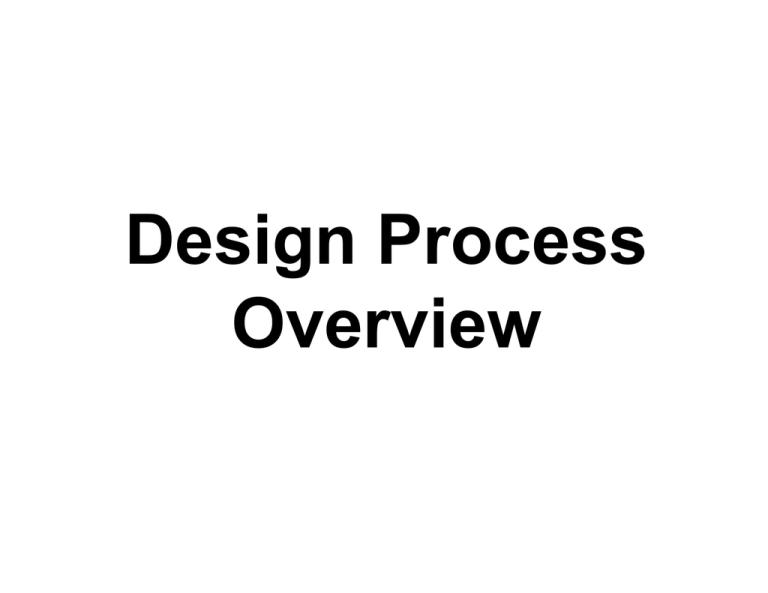
Design Process Overview What is Design? The word “design” is often used as a generic term that refers to anything that was made by a conscious human effort. Design is also a process that is used to systematically solve problems. What is a Design Process? A design process is a systematic problem-solving strategy, with criteria and constraints, used to develop many possible solutions to solve or satisfy human needs or wants and to narrow down the possible solutions to one final choice. – ITEA Standards for Technological Literacy Design Process There are several design processes used in the different technical fields. The following are examples. Example Design Process 1. Identifying problems and opportunities 2. Framing a design brief 3. Investigation and research 4. Generating alternative solutions 5. Choosing a solution 6. Developmental work 7. Modeling and prototyping 8. Testing and evaluating 9. Redesigning and improving – Design and Problem Solving in Technology Example Design Process 1. Identify the need 2. Define the criteria 3. Explore/research/investigate 4. Generate alternate solutions 5. Choose a solution 6. Develop the solution 7. Model/prototype 8. Test and evaluate 9. Redesign and improve – Engineering Drawing and Design (3rd edition) The following is the design process used for this course. Example Design Process 1. 2. 3. 4. Define a Problem Brainstorm Research and Generate Ideas Identify Criteria and Specify Constraints 5. Explore Possibilities 6. Select an Approach 7. Develop a Design Proposal 8. Make a Model or Prototype 9. Test and Evaluate the Design using Specifications 10. Refine the Design 11. Create or Make Solution 12. Communicate Processes and Results 1. Define a Problem • Receive a problem to solve from the client. • Gather information. • Be inspired through media exposure of a current problem and take action. 2. Brainstorm • Present ideas in an open forum. • Generate and record ideas. • Keep the mind alert through rapidly paced sessions. • Develop preliminary ideas. 3. Research and Generate Ideas • Conduct interviews with those affected by the problem. • Research solutions that may already exist; identify shortcomings and reasons why they aren’t appropriate to a given situation. • Compile ideas and report findings to the team. 4. Identify Criteria and Specify Constraints • Identify what the solution should do and the degree to which the solution will be pursued. • Identify constraints (i.e., budget and time are typical considerations). • Draft the Design Brief. 5. Explore Possibilities • Consider further development of brainstorming ideas with constraints and tradeoffs. • Explore alternative ideas based on further knowledge and technologies. 6. Select an Approach • Review brainstormed information and answer any lingering questions. • Narrow ideas down through a voting process, or by use of a decision matrix. • Decide on final idea, usually through group consensus. 7. Develop a Design Proposal • Explore the idea in greater detail with annotated sketches. • Make critical decisions such as material types and manufacturing methods. • Generate through computer models detailed sketches to further refine the idea. • Produce working drawings so the idea can be built. 8. Make a Model or Prototype • Make models to help communicate the idea, and study aspects such as shape, form, fit, or texture. • Construct a prototype from the working drawings, so the solution can be tested. 9. Test and Evaluate the Design Using Specifications • Design experiments and test the prototype in controlled and working environments. • Gather performance data; analyze and check results against established criteria. • Conduct a formal critique to flesh out areas of concerns, identify shortcomings, and establish any need for redesign work. 10. Refine the Design • Make design changes; modify or rebuild the prototype. • Make refinements until accuracy and repeatability of the prototype’s performance results are consistent. • Update documentation to reflect changes. • Receive user’s critique to provide outside perspective to help determine if established criteria have been met. 11. Create or Make Solution • Determine custom/mass production. • Consider packaging. 12. Communicate Processes and Results • Communicate the designer’s final solution through media such as PowerPoint, poster session, technical report. • Market the Product. • Distribute.
